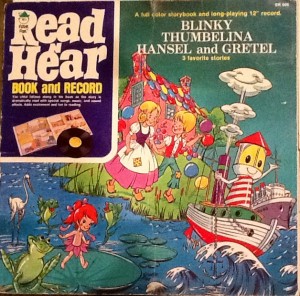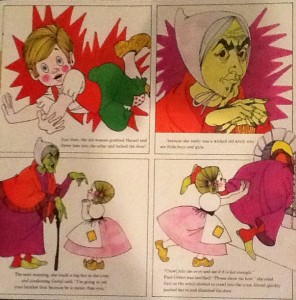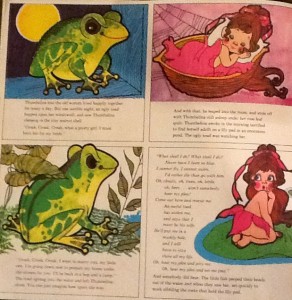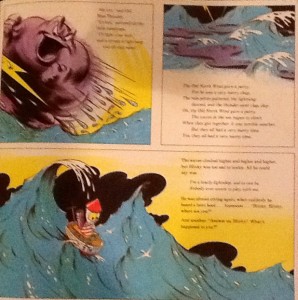Each year I ask my students in the room to draft a personal narrative regarding their entry into literacy. This is more than a “How did you learn to read” invitation. It’s designed to prompt my young readers and budding writers to think beyond the books and the titles that they may remember (some of my students remember none) and to think about the stories they DO know from their childhood.
For my students, this would be pulling back from a decade of experiences. For some more, but, for many, the entrance into school is their entrance into story and ultimately into a sense of what it means to read. And what it means to be a reader.
For the lead reader in the room, it is a little more difficult. Or is it?
For this post, I am pulling back a record that will celebrate its 42nd birthday this year. It is one year younger than I. And I would have come into possession of this record when I was five or six. For the lead learner in the room, to pull back a sense of narrative–about story and how I came to it–is a feat of pulling back a scene that is over thirty-seven years old this winter.
But I can go right back to this long-playing record, from the Peter Pan Records READ N HEAR series, and remember the little boy sitting on the burgundy shag carpeting that lay in the living room of his mobile home on Greenwood Church Road> He is wearing a white t-shirt with a pattern designed from blue, vintage unicycles.
The devil is in such detail, but so is the sense of story and from whence this sense stems.
There are three stories on this record which promises a “multisensory approach to reading approved by reading specialists.”
It is these stories that I will want to hear over and over again as they play from my mother’s record player, one of her prized possessions. A record player we no doubt bought on time from Fingerhut. One that should not be handled by a child’s hands. But yet the mother trusts the boy to be gentle as he releases the arm of the record player and drops the needle into the grooves of the record.
The first story on the record is that of Hansel and Gretel. It is the story of a father who loves his children very much, but he is convinced by a step-mother to drive his children into the woods. I have a connection with this story. I–too–have a step-mother.
And while the years have gone by that have brought me to regard this woman as my “step-in” mother, I am drawn to the connectivity of the story. That my “step-in” mother has passed away and is thought of fondly does little to change the effect of having this record in my hands as a child. This is the power of story. It is steeped in place. That place is our quiet reader’s heart that processes like a pump the world into which we enter and the world into which we return.
Northern Michigan has many a wood. It may be important to be good in this case. And I listen for the “why” of the step-mother’s desire to be rid of these children.
The next story on the record is Thumbelina, a girl so small she could sleep inside a nutshell. Wished for by an old woman who had no children and who sought the counsel of a fairy, a five-year old boy is wondering how we come to be where we are. Who made these hands? Who made these feet? Who wished for me one night and brought me from some other manner of being into this one?
I listen to the record.With a story intertwined with song, Thumbelina is taken from the windowsill of a covetous frog, is rescued and taken into the caretaking of a gentle fieldmouse who introduces her to her friend, a mole, who would keep and posess Thumbelina.
When Thumbelina finds an injured bluebird and nurses it back to health, she finds herself on a magical flight wherein she meets a prince of her own kind.
My five-year old self would not know who Joseph Campbell was. This is what forty-three year old selves are for. . .
And finally, the story of Blinky the Lightship begins to play through the record player. While it is not my favorite story from the record, I listen with each playing. It completes the collection. The obstacles placed in the way of Blinky as he pushes forward will quietly carry me through my own windstorms later in life. How are we not touched by the stories that bring light into our lives–the lights that will help us to see out of the dark?
Three stories on one long-playing record. A record, I might mention, that has found its way back to me. Oh, I wish that I could tell you that it was found in some box or attic space. That this the very record I held gingerly between two index fingers as demonstrated by my mother. And it could very well be, except that I had to go to the internet to find it. I am encouraged by the scratches I see when I hold the record up to the light. Someone has been here.
Some reader has walked these “tracks.”
But it is here. The record.
And I am here. The recorder–as it were.
This is the power of story. Of memory. Of our ability to remember how we came into story and ultimately into literacy.
We can invite our students–our young readers and writers–to retrace their steps. To listen to the playback. To remember–to put the needle to–the stories that drew us. The stories that sustained us. The stories that became the soundtrack of our lives and meddle like an earworm when we wonder–why am I thinking about _____________ today?
The definite nature of “here.”
That it couples itself with our sense of “now” as we call it forth. Then. . .to now. We need this like a flower needs the rain.
The need to go into the woods, to hop aboard the wings of a southerly-bound blue bird, to speed toward the light.
Thank you for the record, mother. And thank you for trusting me to use it as a child. You thought you were intrusting me with the care of a stereo, but you were really affording me the opportunity put my finger upon the pulse of story much like one would put the needle into the groove of a record.
Looking back, looking in. . .and now looking forward. . .this day is another track on the record of our own story.
Let’s take it for a spin, shall we?





I was just talking to a friend about these read and listen books this morning. Thumbelina was my favorite. Made me a little teary eyed to see some of this artwork from my childhood. Thanks!